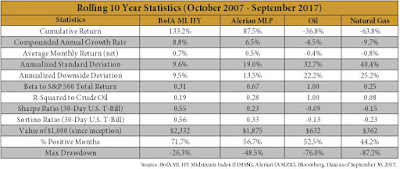Investing in Midstream via Credit is Lesser Known, More Difficult
By Sharam J. Honari
Guest Columnist
Investing in the midstream energy sector via MLP and midstream equities is well known. However, investing in midstream via credit is lesser known and more difficult despite credits’ historical risk-adjusted outperformance relative to equities.
Investors were drawn to MLP equities over the past decade due to their attractive yield, “stable” cash flow business model, growing distributions, relatively low correlation to the broader equity and commodity markets, and interest rates over the long-term. The commodity price downturn and the coinciding decline in production growth rates during the past few years shattered many of these assumptions. While MLP and midstream equities have suffered sharp declines, midstream credits continue to benefit from the sectors focus on improving balance sheets.
Midstream credits are an alternative to MLP equities as they provide good sustainable yield and principal appreciation potential. HY midstream credit has handily outperformed MLPs year-to-date and over the last one, three, five and 10-year cycles. Statistically, midstream credits have generated better cumulative returns relative to MLPs, oil and natural gas, with more consistent and less volatile returns.
Historically, HY midstream credit also provided better risk-adjusted returns than MLP equities due to their lower correlation to oil price swings and the broad equity market indices. Midstream credit experienced roughly half the volatility and drawdown of MLPs during the 2014-2016 crude oil price collapse, benefiting from its seniority in the capital structure. Unlike LP units/equity, credits also do not have distribution cut risk. As such, credit provides significantly less downside risk to principal and a greater margin of safety relative to equity investments during times of stress.
Distribution safety is a well-known risk with MLPs, as most midstream companies experienced stretched balance sheets during the current commodity down cycle. As a result, many well-known industry heavyweights announced distribution cuts. These companies have great assets; however, their balance sheets could not support their previous distributions in a range-bound commodity environment. Most midstream companies are reliant on capital markets to fund their growth; therefore, they are incentivized to retain balance sheet discipline and maintain better ratings and a lower cost of capital. While the distribution cuts are painful for equity holders, they are necessary to preserve a healthy balance sheet and ultimately a positive for creditors.
The total equity market capitalization of midstream energy is roughly $620B when adjusted for float (i.e. how much is available to public investors), the investable universe is somewhat lower. This compares to total midstream debt outstanding of roughly $400B.
We view the midstream sector favorably and believe midstream credits will continue to be a good alternative to MLP equities. Unlike equities, there are many technical nuances to analyzing credit as debt can take various forms. Debt may be floating rate, secured or unsecured, loan or bond, public/private issue, or even a hybrid (fixed-to-float coupon schedule). These various tranches of debt provide investors with numerous avenues to express their investment bias within the capital structure of a company and often lead to a better risk-adjusted approach to invest in a specific asset or company.
The views expressed herein do not constitute research, investment advice or trade recommendations and do not necessarily represent the views of BlackGold or TEXPERS.
 |
| Sharam J. Honari |
About the Author:
Sharam Honari joined BlackGold in 2012 and is a Partner, overseeing the business functions across the firm and serves on the Risk and Valuation Committees. Honari has more than 19 years of equity, credit and trading experience. Prior to joining BlackGold, he spent 2005 to 2012 at Moncrief Willingham Energy Advisors, a Houston-based long/short energy equity fund, as a partner involved with investments, risk management, hedging, trading, and marketing activities. Prior to Moncrief Willingham, Honari was a principal at ETG LLC in San Francisco from 2002 to 2005 and as senior trader/analyst at Fair Haven Capital, LLC in Boston from 1999 to 2002. He began his career at Deutsche Bank Securities in New York in 1997 on the Institutional Equity Trading Desk. He received his bachelor's degree from the University of Washington and earned an MBA from Columbia Business School.







No comments:
Post a Comment